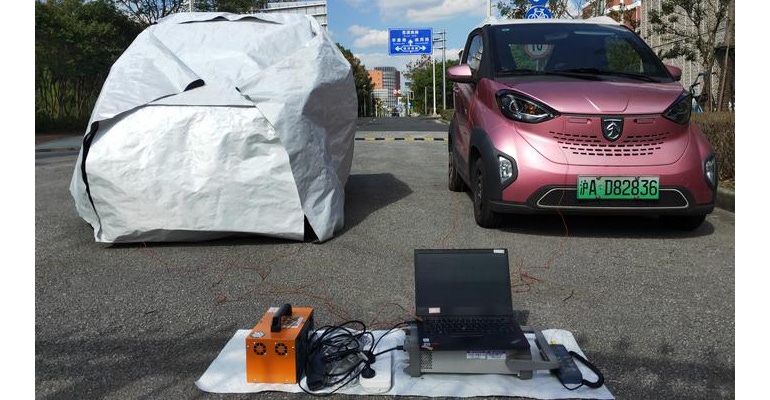EV Battery Overheating Worries? Thermal Cloak Has That Covered
A novel thermal cloak passively keeps electric vehicles cool in the summer and warm in the winter.
July 13, 2023

When an electric vehicle is parked outside, its temperature can swing wildly from day to night and season to season, which can lead to deterioration of the battery. To dampen these fluctuations and extend the battery’s lifespan, researchers have designed an all-season thermal cloak that can cool an electric vehicle by 46.4 degrees F on a hot day and warm it by 44.2 degrees F at night. The cloak, made predominantly of silica and aluminum, can do so passively without outside energy input and operates without any modification between hot or cold weather. This prototype is described July 11 in the newly launched Device, an application-oriented sister journal to Matter, Joule, and Cell.
“The thermal cloak is like clothes for vehicles, buildings, spacecrafts, or even extraterrestrial habitats to keep cool in summer and warm in winter,” stated senior author Kehang Cui, a materials scientist at Shanghai Jiao Tong University.
Reflecting outward and absorbing within
To dampen natural temperature fluctuations, the cloak isolates the car—or any other object beneath it—from the surrounding environment. The cloak has two components: an outer layer that efficiently reflects sunlight and an inner layer that traps heat inside. Whatever heat the outer layer absorbs is emitted so that it can be readily dissipated to outer space. This design earns it the name of Janus thermal cloak, inspired by the two-faced Roman god Janus.
“The cloak works basically the same way the earth cools down, through radiative cooling” stated Cui. “The earth is covered by the atmosphere, and the atmosphere is transparent to a certain range of electromagnetic energy we radiate.”
While this process is desirable in the summer, it would make the car colder during the winter months. “You have to develop something that can turn on and off by itself without external energy input, and that's extremely difficult,” noted Cui.
‘Photon recycling’
Cui and his team designed the cloak to automatically counteract this effect in the winter. The cloak employs an effect called “photon recycling”—essentially, any energy that is trapped under the cloak will bounce back and forth between the car and cloak rather than escape to the surroundings outside.
To assess the performance of the thermal cloak, the researchers conducted tests on electric vehicles parked outside under typical ambient conditions in Shanghai. While the cabin temperature of an uncovered car reached 123 degrees F at mid-day, the cabin of the cloak-covered car reached 73–82 degrees F lower than the uncovered car and 46 degrees F lower than the temperature outside. At midnight, the covered car stayed 44 degrees F higher than the temperature outside, never dropping below32 degrees F.
“This is the first time that we could achieve warming above the ambient temperature by almost 7°C during winter nights,” says Cui. “This is also kind of surprising to us—there’s no energy input or sunshine and we can still get warming.”
The outer component of the cloak is made of thin fibers of silica that were then coated in hexagonal boron nitride flakes, a ceramic material similar to graphite that enhances the fibers’ solar reflectivity. These fibers are then braided and woven together into a fabric and adhered to the inner layer, which is made of aluminum alloy.
The team purposefully designed the cloak to make scaling up production easier in the future. For example, using thinner silica fibers would have increased solar reflectivity, but they would be weaker and couldn’t be made with high-volume, industrial-level production techniques already available. In addition, the materials used, including aluminum, silica, and boron nitride, are all low-cost and make the cloak lightweight, durable, and fire-retardant.
About the Author(s)
You May Also Like





